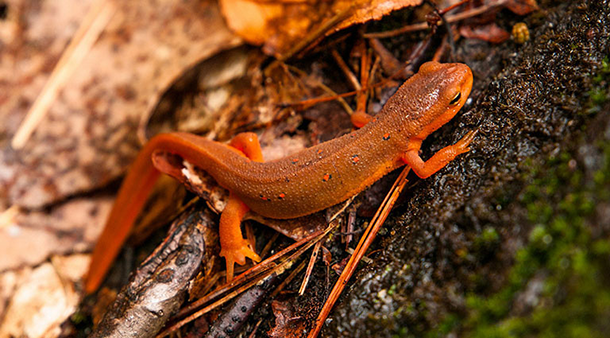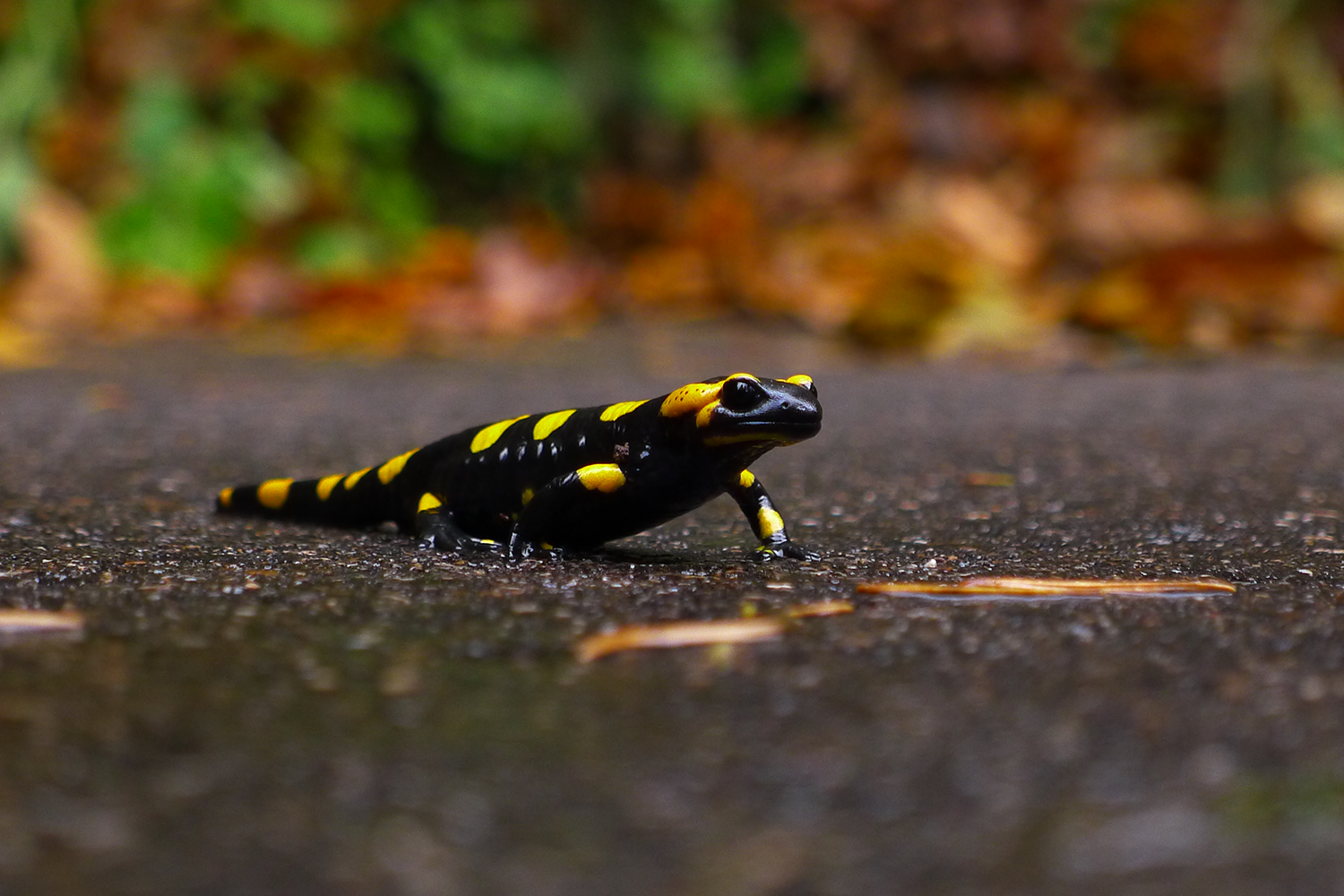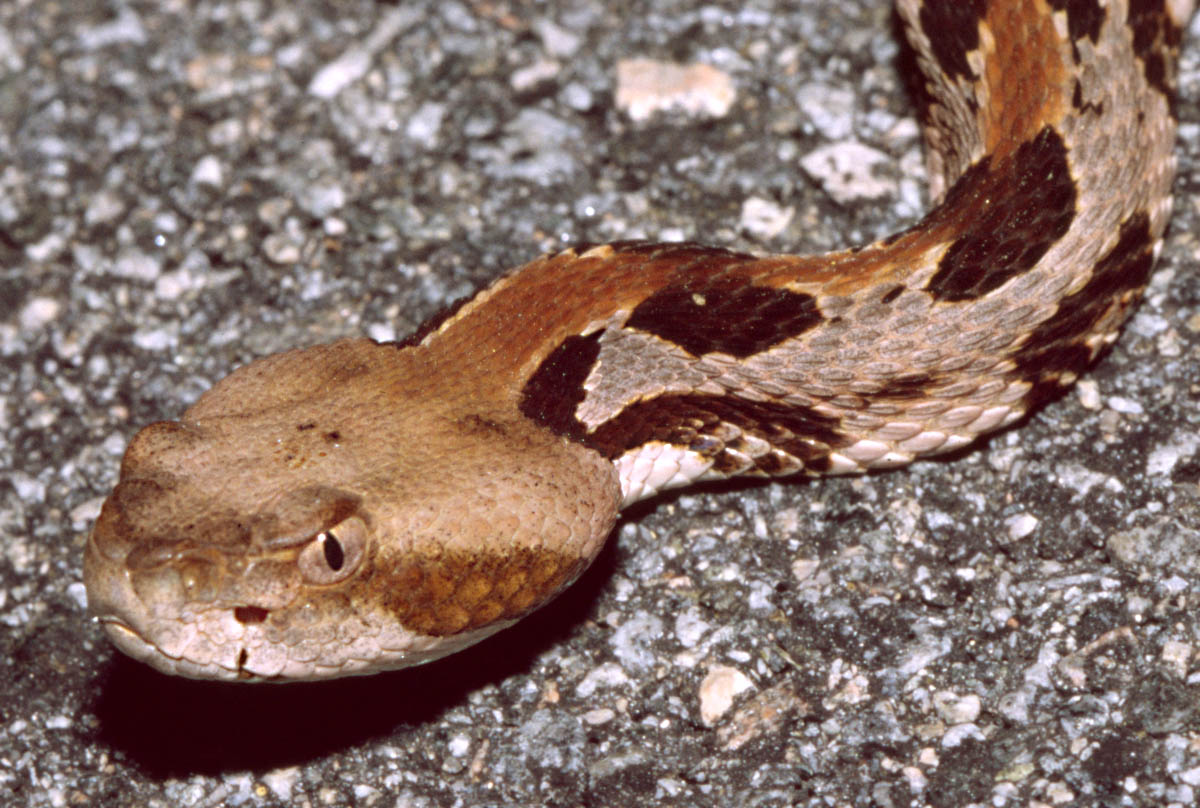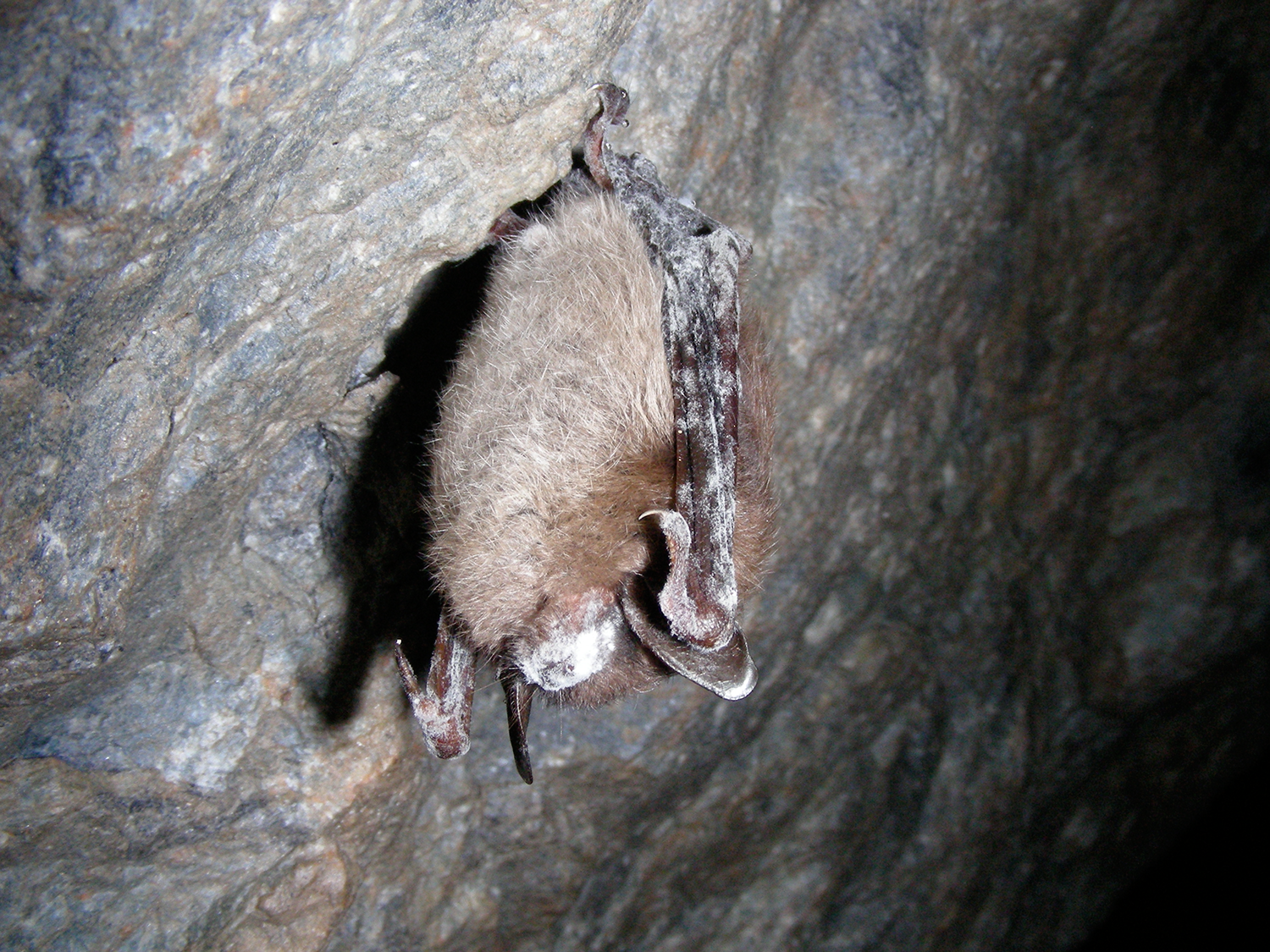Fungal Diseases Surge, Threatening Species Around the World
Air Date: Week of February 26, 2016

A red spotted newt. These salamanders could be threatened by the fungal disease, bsal (Photo: US Fish and Wildlife Service)
From the chytrid fungus in frogs to white-nose syndrome in bats, fungal diseases have been wreaking havoc on many animal species around the world. Writer Elizabeth Kolbert authored an article about the global surge in these diseases in Yale’s magazine E-360. She discusses the causes and possible actions to protect animals in the future with host Steve Curwood.
Transcript
CURWOOD: From white-nose syndrome in bats to the chytrid fungus that kills frogs, fungal diseases are increasingly threatening many animal species around the world. These kinds of infections have become so widespread they caught the attention of Elizabeth Kolbert. She’s the author of the book "The 6th Extinction: an Unnatural History", and recently wrote about the rise of fungal diseases and wildlife for Yale’s online magazine e360. She joins us now from her home in Williamstown, Massachusetts to discuss what might be triggering these fungal outbreaks. Welcome back to Living on Earth, Elizabeth.
KOLBERT: Thanks for having me back.
CURWOOD: So, in this piece you describe a number of different fungal diseases that are impacting wildlife around the world. Let's start with the snake fungal disease.
KOLBERT: Yes, that's a somewhat mysterious one. It was first noticed a decade ago in Florida. People were doing a snake census and they noticed snakes with these lesions on them. And since then it's been found in about 10 states and has caused major die-offs, including one in New Hampshire among a very threatened population of rattlesnakes.
CURWOOD: Yeah, so I guess half of the timber rattlers in New Hampshire have vanished, huh?
KOLBERT: Exactly, and that was a very small population to begin with, so that raised alarms.
CURWOOD: How does the fungus affect the snakes?
KOLBERT: Well, very recent research shows that it eats the scales of the snakes and it causes these skin lesions, and lesions even, I think, in their internal organs, and that's how it kills them.

Fire salamanders in Europe have been devastated by the fungal disease, BSal (Photo: Aah-Yeah, Flickr CC BY-2.0)
CURWOOD: Now, in your piece you say that there is a huge impact on salamanders in Europe — hasn’t come to North America yet, I gather.
KOLBERT: That's a newly emerging fungal disease. It's become known as "Bsal". It's in the same sort of family as the fungal disease that’s afflicting frogs. And what happened in Europe is people started noticing in Belgium and the Netherlands that these salamanders, known as the fire salamander, that their populations were crashing. Some of them were even eliminated. And they traced it pretty quickly to this imported disease. It seems to have come in on, probably on amphibians that were recorded as part of the pet trade or exotic animal trade from Asia. And because of the absolute devastation that has occurred because of the fungal disease that's afflicting frogs and toads, scientists really jumped on this and said, let's try to prevent this disease from spreading. So a group of scientists in Europe did experiments, and they showed that this particular fungus could be fatal to a lot of different species of salamanders. North America is actually the center of salamander diversity, so American scientists, researchers, were very concerned that we could also get this disease either from some animal that was imported from Asia or one that's now imported from Europe. So they actually petitioned the Fish and Wildlife Service, which has the power to restrict imports under something called the Lacey Act, which is an old, from the beginning of the 20th century act. And just recently, the Fish and Wildlife Service announced it was going to restrict salamander imports because of fear of this disease spreading to the US.

Timber rattlesnakes are threatened by Snake Fungal Disease. (Photo: Tom Spinker, Flickr CC BY-NC-ND 2.0)
CURWOOD: So there's a big problem for salamanders in Europe, big problem for snakes here in North America, big problem now for bats in North America. What's going on here? Is this just a coincidence that this is all happening at once?
KOLBERT: Well, that is sort of the question at the center of all this. I know it was certainly the question that prompted me to write that piece for e360, and the answers were not sure. People looking at lists of new and emerging diseases have noticed that fungi are playing a bigger and bigger role. And the question of whether that is a function of the effect that fungi are extremely adaptable, they travel really well, they can cross oceans very easily, they can be dormant for a really long time and then bring spring back to life under the right circumstances — or whether it is perhaps more of a symptom, rather than a cause. Fungal diseases tend to infect people with compromised immune systems. So are we seeing sort of globally compromised immune systems in wildlife, and is that giving fungi an opportunity, so these are opportunistic infections, and is that why we’re seeing it now.
CURWOOD: Let's tease these apart. So one theory here, then, is that this is all the function of being invasive species, that the fungi are coming to places where they haven't been before and the animals are susceptible. What's the evidence for that? What's a good example of that?
KOLBERT: White nose syndrome, which is the bat killing fungus is a pretty good example of that. This is a fungus that has been traced back to Europe. It's pretty clear it was introduced to the US from Europe and perhaps even by some unsuspecting tourist, but what we saw with that disease is we saw it come — literally — we saw the first populations being hit in up state New York, and we saw it spread from there, as you would imagine with a new kind of infection. So that, I'd say, is the best example of something that we're pretty confident is a recent introduction.
CURWOOD: But this snake fungal disease doesn't follow this pattern, so what could be going on there?

A hibernating little brown bat afflicted with white-nose syndrome (Photo: US Fish and Wildlife Service)
KOLBERT: Right, well that is the snake fungal disease which seems to have popped up in different places, more or less at the same time, and in places that are not even, you know, contiguous. There, scientists who have looked at it seem to be more convinced that this is something that is not just a recent introduction. Now the question is whether it's been around for a long time, and it would be weird for it suddenly to become more virulent in these disparate parts of the world simultaneously. That would sort of be statistically very unlikely. So then the question is, are snakes being laid low by other factors, and therefore have these compromised immune system, and this pathogen has now become more deadly because they just can't fight it off.
CURWOOD: So, what could increase the stress for snakes and salamanders?
KOLBERT: Well, unfortunately, you know we barely have time to talk about all the things that are going on in the world that could be compromising the immune systems of creatures that are out there trying to survive in a very rapidly changing world, as your program has documented over and over again. So, what could be affecting snakes? Climate change, right? So, snakes are cold-blooded. They are very responsive to changes in climate, they may be very responsive to changes in moisture, the fungi may be very responsive to changes in temperature and moisture, so that's one thing. We may be looking at pollution of all sorts, right, toxins, heavy metals, you name it. We're looking at habitat destruction, obviously snakes have preferred habitat, they're being squeezed into tighter and tighter territories. Unfortunately, the list kind of goes on and on.
CURWOOD: The last time we spoke, we were talking about your book "The Sixth Extinction". How does what's going on here with fungal disease play into the arguments you were making in the book?

Writer Elizabeth Kolbert (Photo: Barry Goldstein)
KOLBERT: Well, they're very sort of vivid examples of what I was talking about, perhaps the most vivid, because they are diseases that are hitting many, many species simultaneously, and in several cases that we know of, they were caused by moving stuff around the world. So as we move more and more cargo, as we travel more and more, as the world becomes more interconnected, we are effectively bringing together these evolutionary lineages that have been separated for tens of millions of years. And we are getting a lot of nasty surprises and there's no reason, unfortunately, to think that that is going to end. These interactions are just increasing, and the more you have, even if only a very small fraction of them turn out to be dangerous, you're moving thousands and thousands of species around the world, every day, you just need a very tiny percentage of them to be deadly to create a really, really big problem.
CURWOOD: Now, you've talked to a lot of scientists as you were writing this piece. Who among them has some hope? What do people site as a sign of hope in the face of something as devastating as this?
KOLBERT: Well, I think that one hopeful sign that scientists would point to, and this is a very recent development so I haven't really spoken to people since it happened, but it is that people are waking up to this problem. And so for example, scientists went to Fish and Wildlife, presented evidence that this was a real potential threat and that we need to take preventive steps. And Fish and Wildlife did respond to that, so I think people would point to that as a sense that we've been warned and we are taking that warning seriously.
CURWOOD: Elizabeth Kolbert’s article on emerging fungal diseases is in the journal e360 from Yale. Thanks so much for taking time with us today, Elizabeth.
KOLBERT: Always a pleasure to talk to you guys.
Links
Read Elizabeth Kolbert’s article in Yale’s online magazine e360
Fish and Wildlife Recently Decided to Restrict Salamander Imports to Prevent Spread of BSal
More about white-nose syndrome in bats
Chytrid Fungus and Chytridiomycosis
Elizabeth Kolbert’s latest book is called the 6th Extinction: an Unnatural History
Living on Earth wants to hear from you!
Living on Earth
62 Calef Highway, Suite 212
Lee, NH 03861
Telephone: 617-287-4121
E-mail: comments@loe.org
Newsletter [Click here]
Donate to Living on Earth!
Living on Earth is an independent media program and relies entirely on contributions from listeners and institutions supporting public service. Please donate now to preserve an independent environmental voice.
NewsletterLiving on Earth offers a weekly delivery of the show's rundown to your mailbox. Sign up for our newsletter today!
 Sailors For The Sea: Be the change you want to sea.
Sailors For The Sea: Be the change you want to sea.
 The Grantham Foundation for the Protection of the Environment: Committed to protecting and improving the health of the global environment.
The Grantham Foundation for the Protection of the Environment: Committed to protecting and improving the health of the global environment.
 Contribute to Living on Earth and receive, as our gift to you, an archival print of one of Mark Seth Lender's extraordinary wildlife photographs. Follow the link to see Mark's current collection of photographs.
Contribute to Living on Earth and receive, as our gift to you, an archival print of one of Mark Seth Lender's extraordinary wildlife photographs. Follow the link to see Mark's current collection of photographs.
 Buy a signed copy of Mark Seth Lender's book Smeagull the Seagull & support Living on Earth
Buy a signed copy of Mark Seth Lender's book Smeagull the Seagull & support Living on Earth

